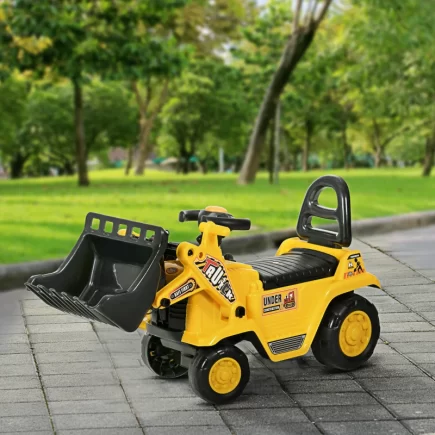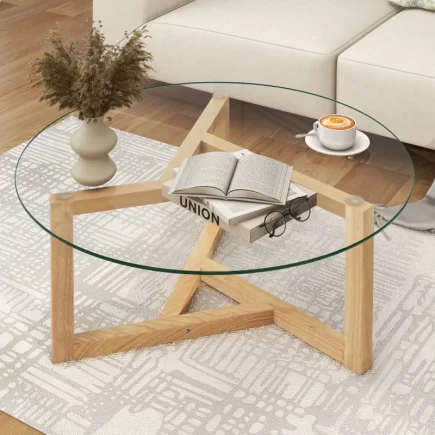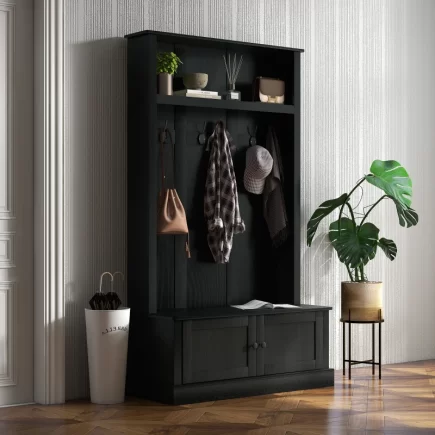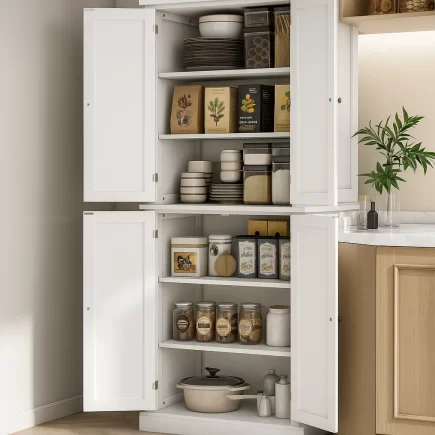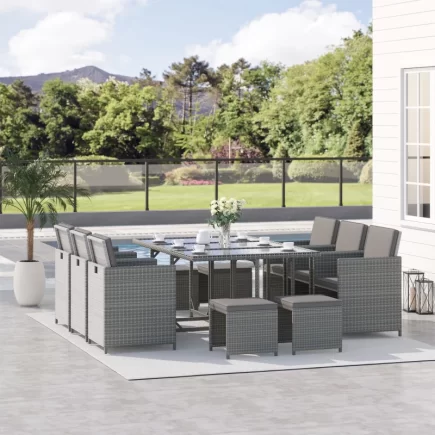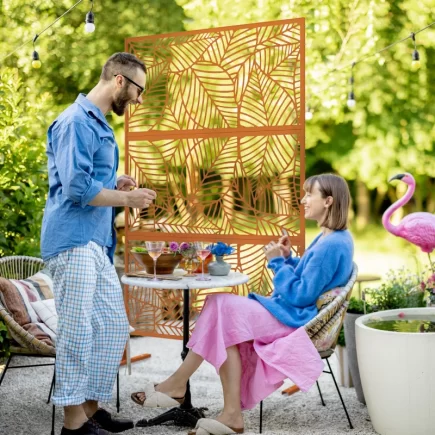A faux tree can brighten a room, add height to a blank corner, and make a workspace feel welcoming. It doesn’t need sun or water, but how you pot it determines whether it looks convincing or cheap. A rushed setup can leave it wobbly or obviously artificial; a proper potting job helps it read as part of your decor.

This guide walks you through what actually matters: picking the right planter size and material, building a weighted base, centering and locking the trunk, finishing the surface so it looks natural, setting the correct scale, and maintaining the display over time. Follow the steps and you’ll get a realistic look that holds up day after day.
Tools and Materials Checklist for Potting a Faux Tree
Before starting, gather everything you’ll need. Having the right tools and materials nearby makes the process smoother and ensures the finished tree looks secure and polished.
Recommended Materials
| Item | Purpose | Notes |
| Faux tree | The centerpiece | Choose one with realistic leaves and trunk texture. |
| Decorative planter | Holds and frames the tree | Select one larger than the starter pot. |
| Fillers | Stabilizes and lifts the tree | Base layer to adjust height and add weight. |
| Decorative toppings (moss, bark, stones) | Covers fillers and improves realism | Pick according to your style and room decor. |
| Adhesive or expanding foam (optional) | For extra stability | Best for tall trees |
Basic Tools
| Tool | Use |
| Garden trowel or scoop | Adding filler materials |
| Scissors or utility knife | Cutting foam, trimming filler |
| Measuring tape | ensuring proportion between pot and tree height |
| Gloves | Protect hands while handling rough fillers |

Choosing the Right Pot Size, Shape, and Material
The pot is more than just a container, it’s part of the visual design. Choose a planter that balances both function and style.

Key Considerations
- Size
- A good rule is to choose a pot 2–4 inches wider than the starter pot.
- Taller faux trees (over 6 feet) need wider, heavier pots for stability.
- Shape
- Wide-based pots provide stability, preventing tipping.
- Tall, narrow pots can look sleek but may require extra filler for balance.
- Material
| Pot Material | Pros | Cons | Best For |
| Ceramic | elegant, heavy for stability | Can chip or crack | Indoor display, living rooms |
| Terracotta | Classic look, breathable | Breaks if dropped | Rustic, earthy decor |
| Plastic/Resin | Lightweight, affordable | Less stable unless weighted | Offices, small spaces |
| Metal | Durable, modern look | Can dent or rust | Industrial, minimalist designs |
| Stone/Concrete | Very stable, long-lasting | Very heavy | entryways, large trees |
Expert Tip: Always check the floor surface. For hardwood or tile, use felt pads under heavy ceramic or concrete pots to prevent scratches.
Preparing the Faux Tree
Even the most realistic faux tree won’t look convincing if the branches are stiff or compressed. Preparing it properly before potting makes a huge difference.
- Unpack and Inspect
- Remove all packaging.
- Check that branches, trunk sections, and leaves are intact.
- Fluff the Foliage
- Spread out branches to create a full, natural shape.
- Bend leaves slightly so they don’t look too symmetrical.
Step 1: Create a Stable Base with Fillers
The base layer determines both the tree’s height and stability. Without it, your faux tree may wobble or sit too low inside the pot.
Process
- Add filler to the bottom of the pot until the tree base sits at your desired height.
- Test by placing the tree in temporarily. Adjust the filler amount if it looks too short or tall.

Popular Base Fillers
| Material | Pros | Cons | Best For |
| Sand | Heavy, inexpensive | Messy if spilled | All pot sizes |
| Gravel or Pebbles | Adds weight, natural look | Can be noisy when shifting | Medium to large pots |
| Soil (dry only) | Natural appearance | Can attract pests | Decorative realism indoors |
| Foam Blocks | easy to cut and shape | Less stable for tall trees | Small trees, lightweight pots |
| Crumpled Paper/Cardboard | Cheap, fills space | Not very durable | Budget-friendly lifts |
Step 2: Position and Center the Tree Correctly
Now it’s time to set the tree in place.
- Place the tree’s starter pot in the middle of your decorative planter.
- Ensure the trunk is straight, not leaning.
- Step back to check from multiple angles before filling in the sides.

Pro Tip: For large faux trees, have someone hold the tree steady while you add fillers. This prevents it from shifting as you work.
Step 3: Secure the Tree for Stability and Balance
Once centered, the tree needs anchoring to prevent tipping.
Methods of Securing
- Add Weight Around the Base
- Fill gaps with sand, gravel, or rocks until the tree feels steady.
- Use expanding Foam or Adhesive (optional)
- Apply foam around the base for tall trees or windy locations.
- Once hardened, cover it with decorative filler.
- Layer Fillers for extra Hold
- Start with heavy fillers like bricks or rocks, then add sand or soil above them.

Expert Tip: Test stability by gently nudging the tree. If it rocks or leans, add more filler until it feels solid.
Step 4: Add Decorative Top Layers for a Natural Look

The finishing touch is what makes your faux tree look authentic.
Step 5: Position the Pot
Place your decorative pot in its final location. Once filled, it may be too heavy to move.

Decorative Options
| Top Layer | Style effect | Best Spaces |
| Moss | Soft, organic | Living rooms, entryways |
| Bark or Wood Chips | Rustic, earthy | Farmhouse, patios |
| Decorative Stones | Clean, polished | Modern interiors |
| Soil (dry) | Realistic garden look | Traditional spaces |
Maintenance Tips: Cleaning and Refreshing Your Faux Tree
Although faux trees don’t need water, they still require basic care to stay looking fresh.
- Dust Regularly: Wipe leaves with a microfiber cloth or feather duster.
- Deep Clean Occasionally: Use a damp cloth with mild soap for stubborn dust.
- Refresh Decorative Fillers: Replace moss, bark, or stones every few months to prevent a faded look.
- Check Stability: Over time, fillers may settle, repack or add more if the tree feels loose.
Tip: Rotate your faux tree every few months to prevent uneven fading if placed near a window.
Troubleshooting Common Problems (Wobbling, Leaning, Visible Fillers)
Even with careful potting, issues can arise. Here’s how to fix them.
- Tree Wobbles or Leans
- Add more heavy filler like sand or rocks.
- Check if the starter pot is centered correctly.
- Visible Fillers at the Top
- Cover with decorative moss or bark.
- Add a thicker layer of stones or soil.
- Pot Too Lightweight
- Place bricks or large rocks at the bottom for stability.
- Switch to a heavier ceramic or concrete pot if needed.
Potting a faux tree the right way is what makes it pass for the real thing. When you choose a properly sized planter, build a weighted base, set the trunk perfectly upright, and finish the surface cleanly, the tree reads as natural, stays put in busy spaces, and adds height and texture without any upkeep drama.
From there, it’s simple maintenance: dust the foliage, refresh the top layer when it looks tired, and re-pack fillers if they settle. Stick to the essentials, correct pot size, solid weight at the bottom, centered starter pot, tight backfill, and a believable top layer, and your display will look convincing from every angle for the long haul. If you’re ready to try the method end-to-end, a Faux Bamboo Tree in a Nursery Pot is a perfect candidate to practice and get a realistic result fast.
FAQs
1. Can I repot a faux tree if I change my décor style later?
Yes, absolutely. Faux trees are versatile and can be repotted anytime to suit your changing style. Just remove it from the old planter, clean off the fillers, and place it in a new pot. A fresh planter can instantly update the look of your space.
2. Do faux trees need drainage holes in the pot?
No, faux trees don’t require water, so drainage holes aren’t necessary. In fact, solid-bottom planters are better because they keep fillers like sand, gravel, or foam in place. This also reduces mess when moving or cleaning the tree.
3. Can faux trees be potted outdoors?
Yes, many faux trees can be used outdoors, but you’ll need a durable planter that withstands weather conditions. Resin, stone, or concrete pots paired with heavy fillers provide stability. Just ensure the tree is anchored properly to prevent tipping in wind.
4. Is it okay to mix real plants and faux trees in the same space?
Definitely, it’s a smart way to add depth and realism. Faux trees provide structure and scale, while live plants add freshness and texture. Just avoid planting them in the same pot, since real soil can create mess around the faux base.
5. How do I choose the right planter color for my faux tree?
The color of the pot can change how the tree feels in a room. Choose a neutral or matching shade for a seamless look, or go for a bold contrast if you want the tree to stand out as a feature. Think of it as part of your overall décor palette.

